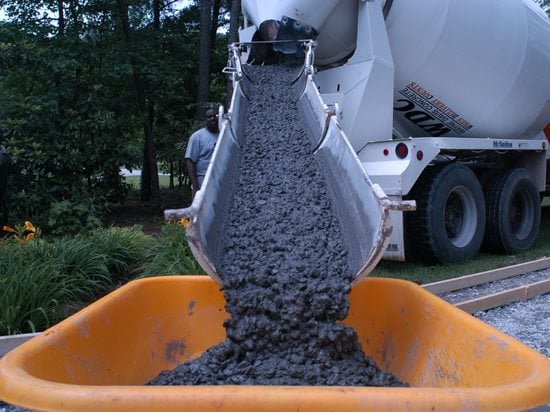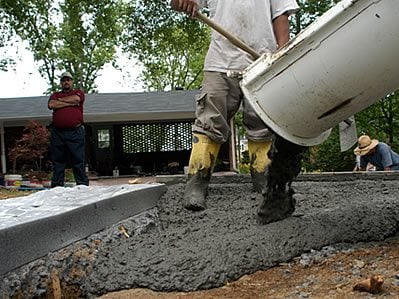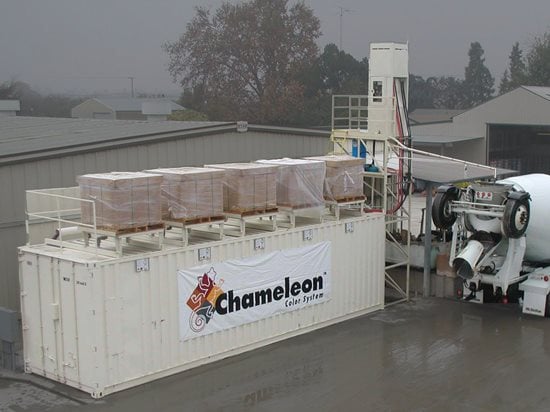- Ordering Ready Mix Concrete
- What is Concrete?
- What is Cement?
- Concrete Mix Design
- Hot Weather Concreting
- Cold Weather Concreting
- Related Information
- Materials: What goes into the mix
- Concrete admixtures: Tips for using in the concrete mix
- Figure out how much concrete you need: Use this concrete calculator
- Pricing concrete: Basic cost considerations
Ready Mixed Concrete Ordering & Delivery
Learn how to order the right concrete, in the right quantity, and delivered at the right time-plus tips for choosing a reliable ready-mix supplierWith all the equipment, tools, and materials you need to purchase for your decorative concrete work, it's easy to neglect the obvious - the concrete itself. Yet ordering concrete should never be an afterthought. Because the material serves as the foundation for all your artistry, its quality and suitability for the job are paramount. By not making this purchase a top priority, you are inviting disaster and risk botching the entire project.
Your first step is to find a reputable ready mix supplier who can supply the material you need at the right time and at a fair price. But that's only the beginning. Placing the actual order is where things get complicated, since concrete is not an off-the-shelf product you can simply shop for out of a catalog.
Find concrete contractors near me.
After years in the business, most concrete contractors have the ordering process down to a science. They’ve found a reliable ready-mix supplier who can get them the right mix, in the right amount, at the right time. In fact, this step of a project is often taken for granted. However, without proper ordering a project can get off to a bad start.
Learn about the entire concrete ordering process here, including how to select a ready-mix supplier, when and how to place the order, as well as what to expect when the concrete is delivered to the jobsite. You’ll also learn why it's important to get the right mix for concrete and what materials go into a good concrete mix. Furthermore, you’ll find tips for matching your concrete mix to jobsite conditions and the type of decorative work you do.
CHOOSING A READY MIX SUPPLIER
Your goal in choosing a ready mix supplier is to get a product that performs, when you want it, and at a fair price. Here is how to do that.
First, Look in the yellow pages under concrete-ready mix. Jot down the phone numbers of 3 or 4 Ready Mix companies. Note the plant locations if that information is given, or call the plants and get their location.
Second, narrow your list down to the two or three suppliers closest to your home (job location). The American Concrete Institute notes that concrete must be discharged form the truck within 1.5 hours of being batched, or 300 revolutions of the truck (whichever comes first)-so the farther away the plant is form your job, the higher the chance for a problem. Also, the farther the delivery distance, the more transportation of the material will cost. Lastly, the farther away the concrete comes from, the more chance of it being late to the job. So getting a supplier who is close to you helps on all three of your goals in choosing a Ready Mix supplier: a product that performs, when you want it, and at a fair price.
Third, get referrals from 2-3 neighbors, or from the local hardware store. Get the referrals from people who have recently done jobs close to the same size as your job. You want to get an indicator of how the Ready Mix company will service someone like you: not how they service the biggest contractor in town.
If you don't have someone to get a referral from, simply call the Ready Mix suppliers and ask them for referrals on two or three jobs your size that they poured in the last week. Call those references and ask:
- Did the concrete arrive on schedule?
- Was it the correct mix?
- How would you rate the service?
- Have there been any problems with the concrete?
- Would you recommend this Ready Mix Company?
Fourth, when you are satisfied you have one or two qualified ready Mix Companies, call those firms for a price based on the concrete you want. Also ask them how many days lead time they need for an order and if you will be able to get the concrete at the time of day you want.
Scheduling a site visit from your ready mix supplier
Reputable ready mix suppliers are usually pleased to have a representative come to your home to check your job several days before the concrete pour. Plan for and schedule this visit ahead of time-do not expect the representative to be able to come out the same day you call.
Discuss with the representative at this time:
- The amount of concrete you calculated, get their opinion.
- Discuss any admixtures.
- Clarify if the site is accessible to Ready mix trucks.
- If you need more than one truck, discuss the spacing of the order.
Confirm with them what you are trying to achieve and the best mix in order to reach that result. The items listed in the admixtures are meant to give you the information to ask the right questions, not make you an expert requiring no assistance from the professionals in the business.
As straightforward as this information is, most dispatchers will say customers calling to order concrete don't know for sure how much concrete they need, don't know if they need any additives, had never considered if the concrete might need to be pumped, and need the concrete tomorrow!
Use a Local Supplier to Save Hauling Costs
As you might expect, you'll generally pay higher transportation costs the farther the ready mix plant is from your work site. But that's not the only reason to go local, whenever possible. The farther the truck has to travel, the greater the chance of it arriving late to the job.
If you're on a remote jobsite or prefer to use a supplier across town, avoid scheduling deliveries during rush hour and recommend alternate routes in case of road construction or traffic congestion.
DETERMINE WHAT YOU NEED THE MIX TO DO
Once you choose a ready mix supplier, it's your responsibility to communicate your performance requirements for the concrete, both in its plastic and hardened states. Only then can the supplier work with you to provide a mix that will achieve the desired results.
When placing concrete on a large stamped concrete project, for example, you may need to slow the setting time to permit enough time for stamping. Your supplier also needs to know the anticipated exposure and service conditions of the concrete once it's in place, so he can supply you with a material strong enough for the application and advise you on admixtures to use to enhance concrete performance, such as water reducers and air entrainers.
Other ingredients you might want to include in your mix recipe include fiber reinforcement (for slabs on grade), integral colors, decorative aggregates, or special-purpose admixtures such as set accelerators or corrosion inhibitors. "Today's concrete can be engineered to meet almost any requirement, no matter how far out you might think it is," says Sparkman. "The key is to communicate your needs to your supplier so he can help you design a solution tailored to your situation."
UNDERSTAND MIX DESIGN BASICS, BUT LEAVE PROPORTIONING TO THE EXPERTS
"You should know the fundamentals of concrete mix design, but it's best to leave the exact proportions to your ready mix producer," says Sparkman. Then if your supplier gets the formula wrong, you will at least have a basic understanding of how the components in a mix interact so you can help troubleshoot the problem. A reputable supplier will welcome your feedback and modify the mix to meet your needs. In some cases, even slight modifications can make a big difference in how the concrete performs.
An indispensable reference book on concrete mix design is Design and Control of Concrete Mixtures, published by the Portland Cement Association (available at www.cement.org).
Good online resources include:
- The National Ready Mixed Concrete Association (www.nrmca.org/aboutconcrete)
- PCA's Cement & Concrete Basics website (www.cement.org/basics)
FIGURE OUT HOW MUCH CONCRETE YOU NEED
Once you work with your supplier to come up with the best mix for your application, the next step is to order the right amount. Errors on the plus or minus side can be equally difficult to remedy. Buying too much concrete is not only a waste of money, but also necessitates finding an environmentally safe way to dispose of the excess. If you're too conservative with your estimate and don't buy enough concrete, you'll be forced to put the project on hold until an emergency delivery arrives - if you're lucky enough to get one on short notice. NRMCA recommends tacking an extra 4% to 10% onto your total estimate to allow for possible errors as well as spillage or over-excavation.
Ready mixed concrete is usually sold by the cubic yard, with the typical truck mixer holding 9 to 11 cubic yards of material. Determining how many yards you need for square or rectangular slabs is fairly straightforward (you can use this concrete calculator to help you do the math). Figuring out how much concrete you need for irregular slab shapes is trickier. When in doubt, ask your ready mix supplier to help you with the calculations.
Use a Local Supplier to Save Hauling CostsAs you might expect, you'll generally pay higher transportation costs the farther the ready mix plant is from your work site. But that's not the only reason to go local, whenever possible. The farther the truck has to travel, the greater the chance of it arriving late to the job.
If you're on a remote jobsite or prefer to use a supplier across town, avoid scheduling deliveries during rush hour and recommend alternate routes in case of road construction or traffic congestion.
PLACING AND CONFIRMING YOUR CONCRETE ORDER
Find a Ready Mix Supplier in Your Area
Placing a successful order
Give plenty of notice as to when you are going to need the concrete, as per your earlier conversation with the Ready Mix Company about lead times.
- Give the time you want the concrete.
- Give the mix number and or type you are ordering.
- Give the total number of yards needed.
- Let them know the spacing you want on the trucks. For example, "I need the trucks 30 minutes apart."
Confirm your order the day before you want the concrete! This is an absolute necessity since so many orders are cancelled. You can not order a week in advance and then never call back!
A checklist to make sure you are ordering the right concrete
- Have you used the concrete calculator to determine how much concrete you need?
- Do you need any admixtures?
- Is the site accessible to Ready Mix trucks? Confirm with your ready mix supplier.
- Upon choosing a Ready Mix supplier, confirm with them what you are trying to achieve and the best mix to order to reach that result. The items listed in the admixtures are meant to give you the information to ask the right questions, not make you an expert requiring no assistance from the professionals in the business.
DELIVERY OF READY-MIX CONCRETE
Determining if the concrete can be placed directly from the truck or will need to be pumped
Can you get a truck up close to where the concrete's final destination is?
Trucks can't get close enough to the pour for four reasons:
- The ground surrounding the project is too wet and the truck will sink.
- The slope leading to the concrete pour is too great for the truck.
- There is too narrow of an opening for where the truck would need to pass to reach where the concrete is needed.
- The pour is big and the trucks chute can not reach everywhere concrete will need to be poured.
Confirm with your Ready Mix Supplier that there is truck access. Each Ready Mix Company has their own criteria on what they feel is accessible for their trucks and should be consulted.
Plan Ahead to Ensure Timely Delivery
Ask the ready mix supplier how many days of lead time are necessary for an order and whether the concrete can be delivered at the time of day you want it (such as before dawn or early evening to avoid placements during the heat of the day). Giving your supplier ample notice will help to ensure priority service and on-time delivery. For additional reassurance, be sure to confirm your order the day before the pour.
For larger projects requiring several truckloads of concrete, also discuss with your supplier the best time sequence for truck arrival. For example, if you estimate it will take your crew an hour to place a full truckload of concrete, then schedule the trucks to arrive an hour apart. Fresh concrete is perishable and will lose quality if it sits in the truck too long. ASTM C 94, "Standard Specification for Ready Mixed Concrete," says that concrete should be discharged within 90 minutes and before 300 revolutions of the mixer after water has been added to the cement.
Make Sure You Get What You Pay For
All the materials in a mix will contribute to the characteristics of the concrete that arrives at your jobsite. Some qualities, such as workability and ease of finishing, are readily apparent as you place the concrete. But others, such as compressive strength and air content, can't be observed. That's why onsite testing of the delivered concrete is important. These tests will assure you that the material you ordered is the same material that arrives in the truck.
Slump (a measure of consistency), air content, unit weight, and compressive strength tests are the most common field tests for determining the quality of freshly mixed concrete. The following ASTM standards give procedures and acceptable time frames for performing these tests, which should be conducted by certified technicians:
- ASTM C 172: Standard Practice for Sampling Freshly Mixed Concrete
- ASTM C 143: Standard Test Method for Slump of Hydraulic Cement Concrete
- ASTM C 138: Standard Test Method for Density (Unit Weight), Yield, and Air Content (Gravimetric) of Concrete
- ASTM C 231: Standard Test Method for Air Content of Freshly Mixed Concrete by the Pressure Method
The unit weight test will also tell whether you're getting the amount of concrete you paid for because it determines the yield of a sample of the ready mixed concrete as delivered, according to PCA. This is a simple calculation, but requires you to know the unit weight of all materials batched. The total weight information may be shown on the delivery ticket or can be provided by your supplier.
Based on the results of these field tests or external factors, such as long delivery times or hot weather conditions, it may be necessary to add air entraining, water reducing, set retarding, or other admixtures to the concrete prior to discharge. Let your ready mix supplier advise you in such circumstances and take responsibility for fine-tuning of the mix. Your supplier can't be held accountable for the quality of concrete that you alter yourself, such as by adding more water.
RELATED:
10 Ways Concrete Contractors Can Save Time & Boost Productivity










